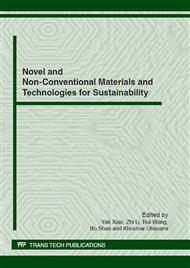p.797
p.801
p.809
p.817
p.824
p.832
p.836
p.844
p.850
Seismic Response Analysis of Railway Frame Piers
Abstract:
By response spectrum method, superposition method based elastic time-history analysis and nonlinear time-history analysis of Newmark-β based linear increasing acceleration method, the finite element models of frame piers 21#~29# of the Ziya River Bridge on Tianjin to Baoding railway are established, and an assistant program code is generated to analyze seismic response of the frame pier. Results indicate that the vibration modes of frame piers are scattered. Only a few modes would be aroused in a narrow band spectrum. And the seismic response obtained by the response spectrum method is generally 10%~20% smaller than which obtained by the elastic time-history analysis. Under seismic excitations along the longitudinal direction, the ratio of displacement difference between two columns to the maximum value is generally liner increased with the increasing of the girder deviation from the centre of the pier beam. And the plastic hinge yielding would occur both at the bottom and the top of pier columns under excitations of the transversal direction. As a result, taking more than 30 vibration modes into account is suggested in a seismic response analysis or design calculation for frame piers. A time-history analysis is recommended as well. The evaluation of earthquake resistant capability of the transversal direction should consider both the bottom and top of the columns, and the anti-seismic capability design of the longitudinal direction is one of the key points for frame piers in the ductility design.
Info:
Periodical:
Pages:
824-831
Citation:
Online since:
June 2012
Authors:
Price:
Сopyright:
© 2012 Trans Tech Publications Ltd. All Rights Reserved
Share:
Citation:


